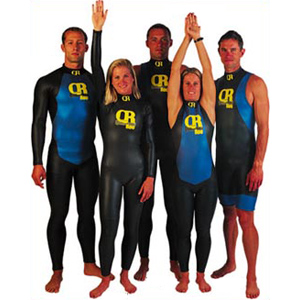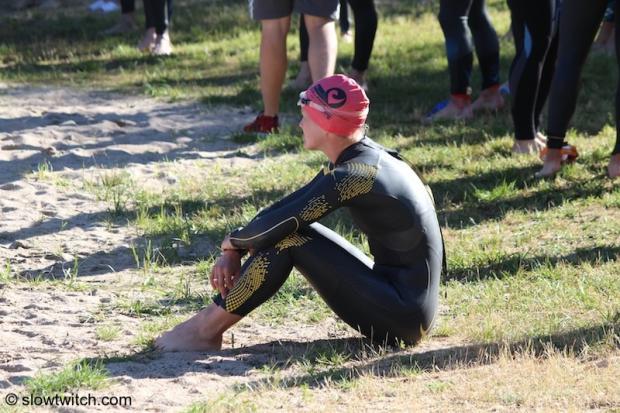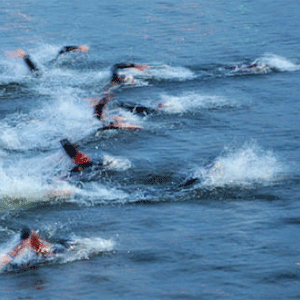Using, Caring for Your Wetsuit

There’s a Part-1 to this (link just below this article’s end), and there’s good news for those looking for the “Wetsuit Dating Service” described. Wetsuit retailers have gotten religion on offering rentals with credit given towards subsequent purchase. These folks are extremely knowledgeable about the fit block of each manufacturer. They can recommend which brand and style best fits your body and your budget.
Manufacturers have gotten on board, partnering with retailers and offering wetsuit demos and clinics where you can try on and swim in a variety of suits, goggles, caps, and also try out swim accessories like snorkels, goggles, etc. I’ve also noticed a few tri clubs also offer loaner wetsuits.
The first generation of Triathlon-specific wetsuits was introduced 30+ years ago (the image here is from the mid 1990s), and in spite of upgrades and advances in materials, construction, and patterning, they are still made of lightweight, buoyant smooth-skin neoprene. Those wetsuits are expensive well-crafted and designed pieces of technical equipment. Take care of your suit, and your suit will take care of you. Let’s talk about how you do that.
Important => Like so many things, use a light touch and don’t hurry. Use steady and firm force, no pinching, overstretching, or pulling on the seams. It’s easier to put a suit on in a cool, dry place and if you are not sweaty. Suits go on better dry and come off better wet.
Getting In
1. Smooth rubber on the outside, fabric on the inside, zipper in the back. Do not use your nails to grip the suit.
2. Put plastic grocery bags on feet (if you can get them.) Otherwise wear socks. Pull the suit over feet and ankles to just below your calves. Take off bags.
3. Work legs up gradually over knees, thighs, and hips, front and back. Make sure to pull the suit up in the back, and work the wrinkles up from behind knees, hamstrings and rear.
4. Pull the crotch up as far as it will go to insure a proper fit in torso, neck, shoulders, and sleeves, but do not tug on inner thighs. Instead, work it up from the calves and knees.
5. Pull suit up over torso. Pull sleeve cuff 3” above wrist bone. Adjust sleeve up into armpit and over shoulder, making sure it ‘s aligned correctly. Straighten arm and reach straight up while adjusting sleeve. Repeat with other sleeve.
6. Adjust suit front and back, pull up to eliminate big folds in crotch, stomach, low back, and elbows. Make sure it is pulled all the way up in back so that it doesn’t pull against the front of your throat. Always work gradually from bottom to top.
7. Pull inner zipper flap flat against back, zip up suit, and make sure flap doesn’t stick in zipper. You may need assistance with this step. Stretch outer zip flap across and fasten, make sure the Velcro doesn’t rub your neck on the side or back. Ask someone to help, whether you’re in a shop, at the race, or at the beach or pool.
8. Position zipper pull cord for easy transition, and recheck sleeves, neck, torso, and legs.
9. The suit should fit snugly, should not feel restrictive in chest, shoulders, or arms. It’ll feel just right in the swimming position in the water. If it’s baggy or pajama-comfy, it’s too big.
Getting Out
10. Unzip and roll down and off one sleeve at a time.
11. Roll suit down inside out over torso, like peeling a banana.
12. On legs, continue to peel down inside out. Do not push down and bunch it up over calves.
13. Step out one leg at a time. If necessary, you can use your hands to slide suit over feet and heels.
14. All of these things take practice. Be sure to put on and take off your suit a few times before your race.
For Faster Transitions (practice, practice, practice…)
1. Suit comes off faster when it’s wet and you’re wet. Coming out of the water, take off sleeves, roll suit down, then step to the side, roll suit down over legs as above, pull it off and carry it over your shoulder. During the run to transition, your legs will get a bit pumped up, and the suit will dry, which makes it extra hard to pull down.
2. If you must run to transition in the suit, then have an extra bottle of water to dump down the front of the suit. It’ll loosen up the suit and make it much easier to peel down.
3. If there are wetsuit strippers at the race, make sure your drawstring is tied.
WARRANTIES: Most tri wetsuit companies have a 1 or 2 year warranty along with a set of instructions and do’s and don’ts. While I was at Quintana Roo, we had quite a few “definitely out of warranty but we can help you anyway” incidents. I’ve listed the most common care instructions, but each company has its own set which should be on the hang tag, printed on the suit, and listed online.
CARE: After each use: Cool, fresh water rinse, hang inside out to dry on plastic hanger. Make sure smoothskin is dry. A little bit of baby powder will help w this. Keep away from heaters and out of sun. Do not hang for more than 2 weeks. Longer than 2 weeks, fold flat and store in cool dry place away from direct heat.
To fold suit for travel or storage:
a. Lay suit flat, zipper side down
b. Fold legs up over chest
c. Cross arms in and X over chest
d. Fold up in half at knees
Every 5 usages, or after a race. Wash with wetsuit shampoo or Kit Wash, following package directions. Rinse well, hang inside out to dry. Make sure both inside and outside of suit are dry. A little talcum or baby powder on the smoothskin side will keep suit from sticking.
If suit smells bad or is moldy from being left wet, dirty, or etc, use enzyme soak (Mirazyme) and then wash with wetsuit Shampoo. Rinse well, hang inside out to dry.
CHLORINE: OK occasionally, not more than 15 hrs total. Chlorine destroys rubber, and will pit the smoothskin, degrade the coating, and fade the inside fabric. Use wetsuit shampoo frequently, and plan to replace the suit after about a year in constant chlorine or saltwater.
PUT YOUR NAME IN YOUR WETSUIT!! Buy a Silver Metallic Sharpie marker at Staples, write your name on the inside and outside of the suit.
WHAT ABOUT swimskins, speedskins, speedsuits? These fabrics are even more fragile than neoprene. Rinse w fresh water after each use, and wash in cold water with Kit Wash or very diluted wetsuit shampoo. Rinse well, don’t wring out, and hang to dry.
LUBRICANTS & CLEANERS: NO PETROLEUM JELLY, COOKING SPRAY, OR OIL!
We don’t care what your buddy, coach, spouse, or magazine column says! Anything but BodyGlide, Go Stik, Tri Slide, or another approved lubricant will degrade the glue, get into the spongy neoprene and fabric, and make it very difficult to repair the suit. Plus it stinks. Some sunscreen products will, over time, turn a wetsuit collar into a gooey mess. So be sure to clean your suit if you get any lotion or grease on it.
Use GoStik, Body Glide, Tri Slide for neck and underarms to reduce chafing, OK on wrists/ankles too for quicker transitions.
Surfing, kayaking, canoeing? Sorry, but the lightweight, flexible low density materials and design of tri suits makes them great for swimming, but the seams and smoothskin rubber simply will not withstand abrasion (surfing,) or sitting kayaking, canoeing, out for beers with friends (sitting will stress the seams and stretch out and tear the rubber.) Well, you can use it for these activities, but the manufacturer might not warranty suits that have clearly been used for non-swimming activities. And if you send in a suit with one ripped knee and covered w surf wax, they might be able to figure it out. Those guys can spot a JSA (Just Swimming Along…) 1500 meters away.
1. WETSUIT SHAMPOO: Originally from McNett.com, a dive company. Wetsuit companies also have their own private label versions. Use according to package directions.
2. KIT WASH: From Chamois Butt’r. Hand wash your wetsuit, technical apparel, and speedsuits.
3. ENZYMATIC cleaner (Mirazyme, also from McNett.com) Use if suit gets moldy, or smelly from other things. Use according to directions, then shampoo suit.
4. NEOPRENE REPAIR GLUE and AQUASEAL: From, you guessed it, McNett.com. Also comes private label from wetsuit companies, retailers and surf shops. Look for it at surf, dive, and scuba shops. Very toxic, smells bad, but really works to repair knicks, larger tears, and small seam separations.
5. UV Tech: Yup, also from McNett.com. This is a protectant that you spray on the outside of smoothskin wetsuits. It conditions and protects the neoprene from sun, heat, and seems to slow down “normal” degradation of the foam.
6. LUBES TO LOVE: Tri Slide by Tri Swim, GoStik by Chamois Butt’r, Suit Juice from Profile Design, and the old standby from way back when, BodyGlide.




Start the discussion at forum.slowtwitch.com